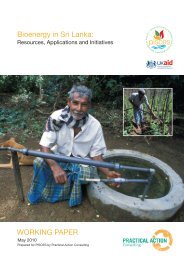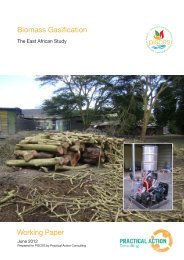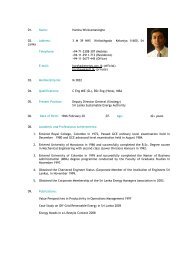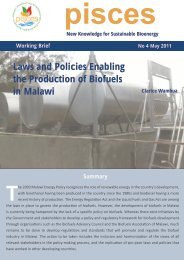Liquid Biofuels Strategies and Policies in selected African ... - Pisces
Liquid Biofuels Strategies and Policies in selected African ... - Pisces
Liquid Biofuels Strategies and Policies in selected African ... - Pisces
You also want an ePaper? Increase the reach of your titles
YUMPU automatically turns print PDFs into web optimized ePapers that Google loves.
The issues emerg<strong>in</strong>g from large-scale biofuels production <strong>in</strong> Tanzania <strong>in</strong>clude:• Technology development versus l<strong>and</strong> tenure.• Lack of real agro-climatic knowledge or assessment of truly commercial ra<strong>in</strong> fedfeedstock’s.• Local process<strong>in</strong>g versus export of raw materials.• Lack of robust social <strong>and</strong> environmental safeguards.• Inequitable bus<strong>in</strong>ess models.Lack of policies <strong>and</strong> regulations have made <strong>in</strong>vestment <strong>in</strong> the biofuels sector difficult<strong>in</strong> Tanzania as the prospective return on <strong>in</strong>vestment rema<strong>in</strong>s largely unclear. Legislativeframeworks have been previously <strong>in</strong>complete, overlapp<strong>in</strong>g <strong>and</strong>/or lack<strong>in</strong>g completecoherence to ensure all stakeholders are <strong>in</strong>volved. Activities towards implementationof biofuels policies are currently ma<strong>in</strong>ly driven by the M<strong>in</strong>istry of Energy <strong>and</strong> M<strong>in</strong>erals(MoE), with a multi-stakeholder group now <strong>in</strong>volv<strong>in</strong>g other m<strong>in</strong>istries. COMPETE havecreated layered crop l<strong>and</strong> suitability maps for certa<strong>in</strong> areas of Tanzania <strong>and</strong> reportedlygood progress is be<strong>in</strong>g made (Watson, 2010).While quite a few jatropha projects have been explored, started <strong>and</strong> not endured,Sunbiofuels have 2,000 hectares of their 8,000 hectare accession planted out <strong>in</strong>Morogoro <strong>in</strong> degraded forest l<strong>and</strong>s. EcoEnergia, the result of a management buy-outof Sekab, aim to produce 100m litres of ethanol from 400,000 hectares of sugarcane<strong>and</strong> sweet sorghum split between first Bagamoyo, then Rifiji <strong>in</strong> Tanzania <strong>and</strong> CaboDelgado, Mozambique. Indian-owned Kilimanjaro Biochem is construct<strong>in</strong>g an ethanolplant close to Kilimanjaro with 200-800 greenfield hectares of sugarcane. Recently theTanzanian Petroleum Development Corporation announced the <strong>in</strong>tention of import<strong>in</strong>gBrazilian ethanol to cut fuel costs.4.2.12 Ug<strong>and</strong>aUg<strong>and</strong>a’s current energy policy is broadly supportive of the aim of <strong>in</strong>creas<strong>in</strong>g biofuels <strong>and</strong>is geared at reduc<strong>in</strong>g dependence on imported petroleum products. As specific regulatoryframeworks are still be<strong>in</strong>g developed there is not yet any decision on the different scale<strong>and</strong> impact of meet<strong>in</strong>g local energy requirements <strong>and</strong>/or production for export (Byakola<strong>and</strong> Yiga, 2007). Dur<strong>in</strong>g implementation, government support is com<strong>in</strong>g <strong>in</strong> the formof production subsidies, tax exemptions <strong>and</strong> modified tax <strong>in</strong>centives, fuel blend<strong>in</strong>gm<strong>and</strong>ates, tariffs, price regulations, <strong>and</strong> national biofuels targets. International NGOshave set up large scale outgrowers schemes <strong>in</strong> three areas us<strong>in</strong>g jatropha <strong>and</strong> c<strong>and</strong>lenutas feedstocks. Aga<strong>in</strong> there is muted Ch<strong>in</strong>ese <strong>in</strong>vestment support of larger scale sweetsorghum development. Palm oil has been developed <strong>in</strong> areas around the lake <strong>and</strong> onecase of controversial sugarcane expansion was illustrated <strong>in</strong> a previous chapter.4.2.13 ZambiaClimatically Zambia is one of the more favourable zones for biofuels, especiallyjatropha, which is not yet commercial <strong>in</strong> drier or colder climates. Zambia’s 1994National Energy Policy did not <strong>in</strong>clude biofuels issues, but it was revised <strong>in</strong> 2004 toaccommodate biofuels. The Zambian Government had set up an <strong>in</strong>ter-m<strong>in</strong>isterialtaskforce to work on targets, <strong>in</strong>centives <strong>and</strong> capacity build<strong>in</strong>g programs for biofuelsdevelopment (WWF 2008). In order to create a strong private sector leadership,the <strong>Biofuels</strong> Association of Zambia was registered <strong>in</strong> 2006 to promoted biofuels<strong>in</strong>vestment, which has improved Zambia’s energy policy.Examples of stakeholder participation <strong>in</strong> mapp<strong>in</strong>g out the liquid biofuels roadmap <strong>in</strong>Zambia are:• In August 2006 the Government convened a national stockholder’s consultativeworkshop for liquid biofuels development.• In April 2007 the draft <strong>Biofuels</strong> Development Framework was formulated jo<strong>in</strong>tly byGovernment <strong>and</strong> the <strong>Biofuels</strong> Association of Zambia <strong>and</strong> a statutory <strong>in</strong>strument tolegalise biofuels was <strong>in</strong>troduced.• In December 2007 the Government convened a stakeholder workshop to map out astrategy to roll out the National Energy Policy, approved <strong>in</strong> November 2007 (S<strong>in</strong>kala2008).• In May 2008, the Energy Regulation Commission set biofuels st<strong>and</strong>ards but thegovernment is yet to make biofuels a priority area under the national developmentplans as well as to issue <strong>in</strong>centives.By the end of 2008, some large <strong>in</strong>ternational biofuels commercial activities werereported <strong>in</strong> Zambia (WWF 2008) despite the lack of clarity on the export focus ornational energy provision. Proponents of a National <strong>Biofuels</strong> plan claim that fewerhectares are needed to create national self-sufficiency (250,000 Ha for both Bioethanol<strong>and</strong> biodiesel based on optimistic yields) than are currently lost to deforestation fromwood biomass usage every year (estimated at 450,000ha of forest (S<strong>in</strong>kala 2008). Theevidence that current biofuels production is targeted at the export market is supportedby the fact that Zambia does not have its own biofuels ref<strong>in</strong><strong>in</strong>g facilities.Perhaps <strong>in</strong> response to the lack of national <strong>in</strong>tegration of biofuels, well organised civilsociety biofuels forums have emerged, compris<strong>in</strong>g Zambian NGO’s <strong>and</strong> <strong>in</strong>terestedstakeholders, to ‘research, monitor facilitation, dissem<strong>in</strong>ation of <strong>in</strong>formation <strong>and</strong>collaboration with the Government, BAZ <strong>and</strong> the biofuels <strong>in</strong>dustry, to create a pro-poor<strong>in</strong>dustry that contributes to rural development <strong>and</strong> equitable economic growth <strong>in</strong> therural parts of the country, with a particular emphasis on small scale rural producers.’4.2.14 ZimbabweEthanol blend<strong>in</strong>g with petrol started <strong>in</strong> Zimbabwe <strong>in</strong> 1980 <strong>and</strong> ceased <strong>in</strong> 1992 whenunblended fuel became cheaper due to a severe drought. Last year the Triangle ethanolplant was refurbished <strong>and</strong> production resumed. Sugarcane production expansion isplanned at the Agricultural <strong>and</strong> Rural Development Authority estates <strong>in</strong> Chisumbanje.In Zimbabwe, public-private partnerships <strong>and</strong> market coord<strong>in</strong>ation (for blend<strong>in</strong>g,market<strong>in</strong>g <strong>and</strong> transportation) have been critical for the <strong>in</strong>itial establishment of abiofuels programme. The structural adjustment <strong>and</strong> tax <strong>in</strong>centives <strong>in</strong> Zimbabwe wereencourag<strong>in</strong>g <strong>and</strong> private <strong>in</strong>vestors such as Triangle found <strong>in</strong>ternational buyers forportable alcohol. The key replicable lessons for other <strong>African</strong> countries, especiallythose at the early stage of biofuels development are:• Public-private partnerships with oil companies, government <strong>and</strong> biofuelentrepreneurs can be effective <strong>in</strong> creat<strong>in</strong>g economies of scale <strong>and</strong> the value cha<strong>in</strong>.• Feedstock availability (<strong>in</strong>clud<strong>in</strong>g long term climatic <strong>and</strong> market conditions) <strong>and</strong>consistency <strong>in</strong> government policies <strong>and</strong> support helps susta<strong>in</strong> the <strong>in</strong>dustry.42 <strong>Liquid</strong> <strong>Biofuels</strong> <strong>Strategies</strong> <strong>and</strong> <strong>Policies</strong> <strong>in</strong> <strong>selected</strong> <strong>African</strong> Countries <strong>Liquid</strong> <strong>Biofuels</strong> <strong>Strategies</strong> <strong>and</strong> <strong>Policies</strong> <strong>in</strong> <strong>selected</strong> <strong>African</strong> Countries 43









